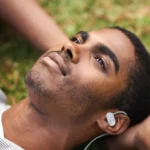
This is the first scientifically validated, CE-marked, non-invasive vagal neuromodulation system proven to optimize heart rate variability—the most reliable biomarker of nervous system health, stress resilience, and longevity.

The First Device Clinically Validated to Optimize Your HRV
Nurosym is the first portable vagus nerve stimulation device with rigorous clinical validation specifically for HRV optimization.
Heart rate variability—the variation in time between your heartbeats—is the most validated measure of how well your nervous system handles stress.
Higher HRV means better stress resilience, faster recovery, and improved overall health. Lower HRV signals impaired stress response and predicts negative health outcomes including cardiovascular disease, cognitive decline, and reduced longevity.
Nurosym delivers direct vagal nerve stimulation through precise electrical signals, activating the primary neural pathway that regulates heart rate variability.
- Validated through 50+ completed research studies and over 4 million user sessions demonstrating measurable, reproducible HRV improvements
- CE Marked medical device certification meeting rigorous safety and effectiveness standards for autonomic function optimization
- Developed through $10M+ research investment with Chicago University Medical School, UCLA, Imperial College London, and 100+ research institutions
- The most researched wearable vagus nerve device available establishing the gold standard for non-invasive HRV optimization
“Among similar wellness devices, it stands out for its strong research foundation and user-friendly design.”
– DEREK, US
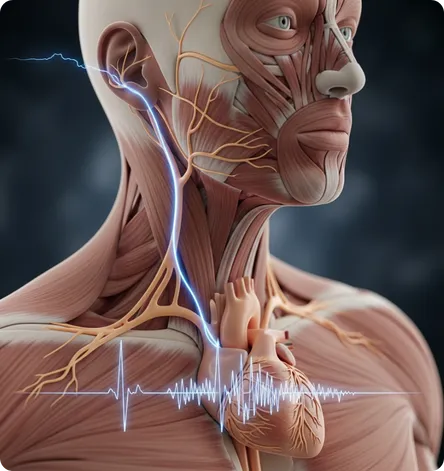
Direct Pathway to Cardiac Autonomic Control
Your HRV is controlled by your autonomic nervous system—specifically the balance between your sympathetic (stress) and parasympathetic (recovery) branches.
Your vagus nerve is the primary parasympathetic pathway to your heart.
When your vagus nerve activates, it releases signals that slow your heart rate and increase the natural variation between beats. This vagal influence on your heart creates HRV. Stronger vagal tone equals higher HRV.
Nurosym delivers precisely calibrated electrical signals to your vagus nerve through your ear. This activates the direct neural pathway from your brainstem to your heart’s pacemaker cells, immediately increasing parasympathetic influence and HRV.
- Targets the auricular branch of your vagus nerve the most accessible and effective location for non-invasive HRV optimization
- Activates the direct vagal pathway to your heart producing immediate increases in parasympathetic cardiac control
- Works through the brainstem autonomic centers that regulate the balance between your heart's stress and recovery systems
- Significantly enhances parasympathetic nervous system activity with measurable changes in HRV markers appearing within one hour (statistically significant at p=0.002), with effects lasting 2-4 hours after each session
“It helps me achieve a state of tranquility similar to meditation. The shift is subtle, but I notice feeling more at ease.”
– TOM, UK

To Reverse Sympathetic Dominance and Restore Balance
Chronic stress, poor sleep, sedentary lifestyle, and aging all reduce your HRV by shifting your nervous system toward sympathetic dominance.
When your sympathetic (stress) system is overactive and your parasympathetic (recovery) system is suppressed, HRV drops.
Low HRV reflects this imbalance—your heart is stuck in a rigid pattern dominated by stress activation, lacking the flexible variability that comes from strong parasympathetic influence.
Vagus nerve stimulation shifts this balance by directly enhancing parasympathetic activity.
This doesn’t just temporarily calm you—it actively retrains your autonomic nervous system toward better baseline balance.
- Reduces sympathetic overactivation by enhancing inhibitory pathways that calm your stress response system
- Increases parasympathetic tone through direct vagal pathway activation, restoring the "brake" on your stress system
- Improves autonomic flexibility the ability to shift appropriately between stress and recovery modes
“Because … of my workplace, because of really high stress … I got severe reflux. The constant push to deliver more work destroyed my organism. Each time I was putting the device I could release tension from my nervous system.”
– JAKUB, UK
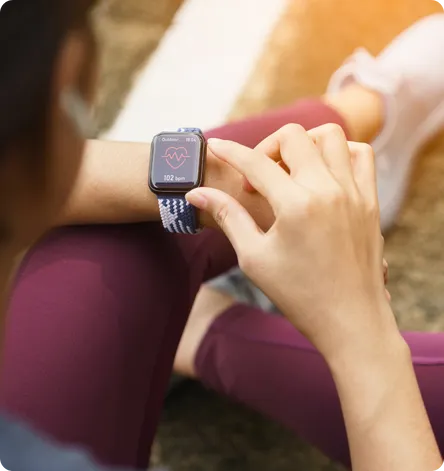
For Measurable, Trackable Nervous System Improvement
One of HRV’s most powerful advantages is that you can measure it. Consumer wearables like Oura Ring, WHOOP, Apple Watch, Garmin, and Polar devices provide daily HRV data, giving you objective feedback on your nervous system health.
This makes HRV the ultimate biomarker for tracking the effectiveness of any health intervention. Unlike subjective measures (“I feel better”), HRV gives you concrete numbers showing whether your nervous system is actually improving.
Nurosym produces measurable HRV changes you can see on your device. This provides objective validation that the intervention is working—and motivates continued use.
- Benefits can be tracked with all major consumer wearables for standardized HRV analysis (Oura Ring, WHOOP, Apple Watch, Garmin, Polar H10, and others)
- Produces measurable physiological changes within one hour of use, with statistically significant improvements in nervous system markers (p=0.002) and effects lasting 2-4 hours after each session
- Delivers cumulative baseline improvements observable over weeks as your nervous system adapts and strengthens
- Enables data-driven optimization allowing you to track which protocols, timing, and duration produce your best HRV improvements
- Provides objective biofeedback connecting your daily sessions to measurable health outcomes
“When I wasn’t getting enough deep, restorative sleep, it impacted my mood and daily routine. Nurosym has completely transformed the way I rest.”
– DANIEL, WALES
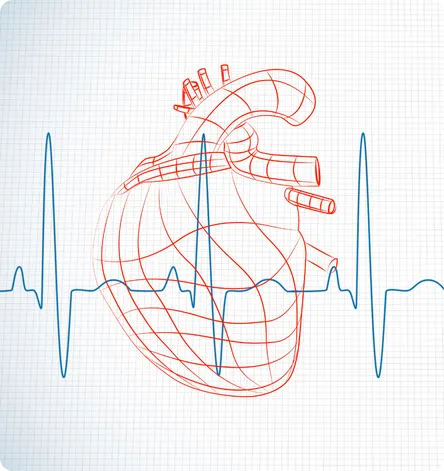
To Support Cardiovascular Health and Longevity
Low HRV is one of the strongest predictors of cardiovascular disease, all-cause mortality, and adverse cardiac events.
Research consistently shows that individuals with higher HRV live longer and have significantly lower risk of heart disease, heart attack, and sudden cardiac death.
Your HRV reflects the health of your cardiac autonomic nervous system—the neural regulation keeping your heart functioning optimally.
When this regulation is impaired (low HRV), your heart loses protective flexibility and becomes more vulnerable to arrhythmias and cardiovascular stress.
Improving HRV through vagus nerve stimulation strengthens this cardiac autonomic regulation, providing protective cardiovascular benefits beyond simple stress reduction.
- Low HRV independently predicts cardiovascular disease risk even after controlling for traditional risk factors like blood pressure and cholesterol
- Higher HRV associates with reduced all-cause mortality across multiple large-scale population studies
- HRV improvement indicates enhanced cardiac autonomic function the nervous system regulation protecting your heart
- Vagal stimulation produces cardioprotective effects including improved heart rate recovery, reduced arrhythmia risk, and enhanced cardiovascular stress adaptation
- Measurable HRV increases reflect improved cardiovascular resilience providing objective evidence of heart health optimization
“Honestly, I’ve noticed such a positive change. I have far fewer days where I feel too drained to keep up with my daily routine.”
– FRANCESCA, UK
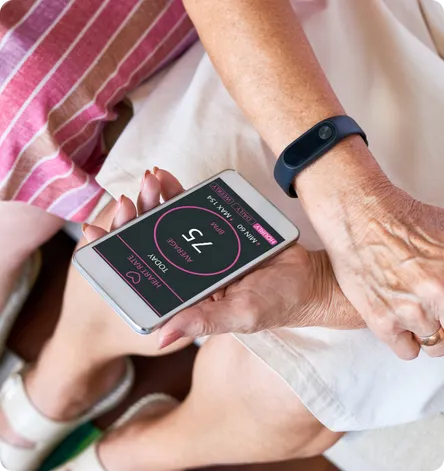
For Improved Stress Reactivity and Recovery Speed
HRV isn’t just about your resting baseline—it’s also about how quickly your HRV drops during stress and how fast it recovers afterward.
Individuals with good stress resilience show rapid HRV recovery following challenges. Poor recovery indicates impaired stress regulation.
This HRV recovery kinetics—how quickly you bounce back—is a critical marker of nervous system health and predicts both physical and mental health outcomes.
Vagus nerve stimulation enhances both aspects: reducing excessive HRV drops during stress and accelerating recovery afterward. This means you handle stressors more efficiently and return to baseline faster.
- Reduces excessive HRV suppression during stress by maintaining parasympathetic buffering capacity even under pressure
- Accelerates post-stress HRV recovery enabling faster return to balanced autonomic function after challenges
- Improves stress-recovery cycles allowing you to handle multiple stressors without progressive autonomic depletion
- Enhanced recovery kinetics predict better health outcomes in both cardiovascular and mental health domains
- Measurable improvements in HRV recovery observable within weeks of consistent use
“Since I started using it, I’ve noticed a significant improvement in how I feel overall. It’s been three months now, and I’m hopeful for even more positive changes—it’s definitely a step in the right direction.”
– TERRY, UK
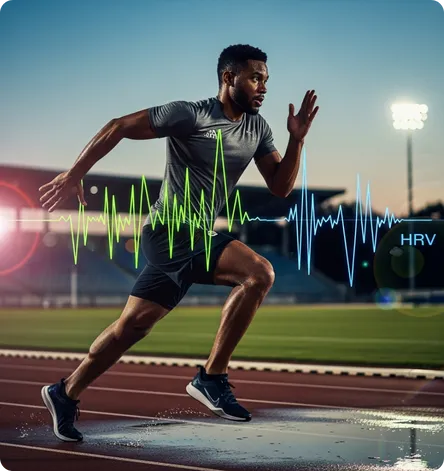
To Optimize Athletic Performance and Recovery
Elite athletes and performance-focused individuals increasingly use HRV as their primary training optimization tool.
Higher HRV indicates readiness to train hard; lower HRV signals insufficient recovery requiring rest or lighter training.
Athletes with higher average HRV demonstrate better endurance, faster recovery between training sessions, reduced injury risk, and improved adaptation to training stress. Many professional sports teams now make HRV-guided training decisions.
Vagus nerve stimulation offers athletes a tool to actively improve HRV rather than simply monitoring it. This accelerates recovery, enhances training adaptation, and maintains higher baseline readiness.
- Higher HRV correlates with superior athletic performance across endurance, strength, and skill-based sports
- HRV-guided training reduces overtraining risk by providing objective recovery status assessment
- Vagal stimulation accelerates post-exercise recovery by enhancing parasympathetic reactivation after training stress
- Improved HRV baseline enables higher training volume by maintaining autonomic capacity for adaptation
- Used by elite athletes and performance professionals as an active recovery tool and HRV optimization strategy
“I was looking for a way to better navigate seasonal challenges. I had tried workouts and meditation apps but discovered Nurosym, and I noticed changes within just a couple of weeks. I feel more balanced and better equipped to manage daily pressures.”
– TIJANA, US

For Sleep Quality Improvement Through HRV Enhancement
HRV during sleep provides critical insight into sleep quality and recovery effectiveness. During deep, restorative sleep, your HRV should be high, reflecting strong parasympathetic dominance. Low HRV during sleep indicates insufficient recovery—your nervous system isn’t fully relaxing.
Many sleep disorders and poor sleep quality manifest as suppressed nocturnal HRV. Improving your ability to achieve high HRV during sleep directly enhances sleep’s restorative benefits.
Vagus nerve stimulation before sleep enhances the parasympathetic activation necessary for sleep initiation and maintenance, producing higher nocturnal HRV and improved sleep architecture.
- High nocturnal HRV indicates quality restorative sleep reflecting proper parasympathetic dominance during rest
- Pre-sleep vagal stimulation facilitates sleep initiation by accelerating the autonomic shift necessary for sleep onset
- Enhanced parasympathetic activity during sleep produces higher HRV throughout the night and deeper sleep stages
- 31% improvement in sleep quality scores as measured by the Pittsburgh Sleep Quality Index over 4 weeks (p < 0.05)[1]
- Better sleep produces higher daytime HRV creating a positive cycle of improved recovery and daytime resilience
“I’ve noticed improved recovery indicators tracked by my fitness device and a greater ability to stay focused or train for extended periods.”
– HENRY, UK

To Support Cognitive Function Through the HRV-Brain Connection
Emerging research reveals strong connections between HRV and cognitive performance. Higher HRV associates with better executive function, faster processing speed, improved working memory, and enhanced emotional regulation.
The vagal pathway connecting your heart and brain enables bidirectional communication—your HRV both reflects and influences your brain function. Low HRV predicts cognitive decline, while HRV improvement corresponds with cognitive enhancement.
This heart-brain connection means HRV optimization through vagal stimulation provides cognitive benefits beyond simple stress reduction.
- Higher HRV correlates with superior cognitive performance particularly in executive functions requiring attentional control
- Low HRV predicts cognitive decline and dementia risk in longitudinal aging studies
- The vagal pathway enables heart-brain communication with HRV reflecting the integrity of this connection
- HRV improvement associates with cognitive enhancement in attention, memory, and executive function domains
- Vagal stimulation produces both HRV and cognitive improvements through shared neural pathways
“Sometimes I’ll put it on while reading, and I find it helps me stay focused, even on more challenging pieces of writing.”
– YVONNE, UK
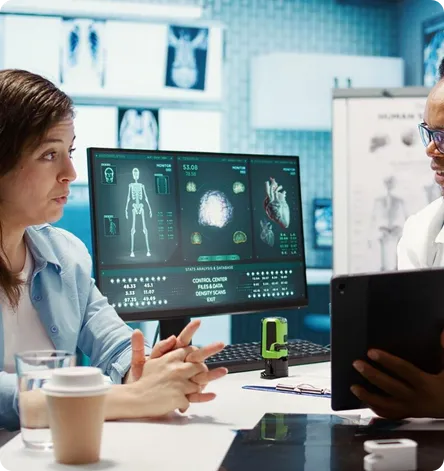
As Objective Biofeedback for Overall Health Optimization
HRV serves as a “master biomarker”—a single metric that integrates information from multiple physiological systems. Your HRV reflects your cardiovascular health, stress system function, sleep quality, recovery capacity, metabolic health, and inflammatory status simultaneously.
This makes HRV the ideal biomarker for tracking overall health optimization efforts. When HRV improves, it signals that multiple systems are improving together. When HRV declines, it provides early warning of health deterioration.
Nurosym allows you to actively optimize this master biomarker, creating measurable improvements that cascade across multiple health domains.
- HRV integrates information from multiple physiological systems providing a holistic health status indicator
- HRV improvement reflects multi-system health enhancement including cardiovascular, metabolic, inflammatory, and stress regulation
- HRV provides early warning of health issues declining before other symptoms appear
- Objective tracking enables optimization showing which interventions (diet, exercise, sleep, stress management) produce real improvements
- HRV optimization creates cascading benefits as improved autonomic function supports every physiological system
“I often deal with tension at night that affects my face and head, but I started to notice a difference—it’s been a positive shift, even in how I feel physically.”
– HOGAN, US
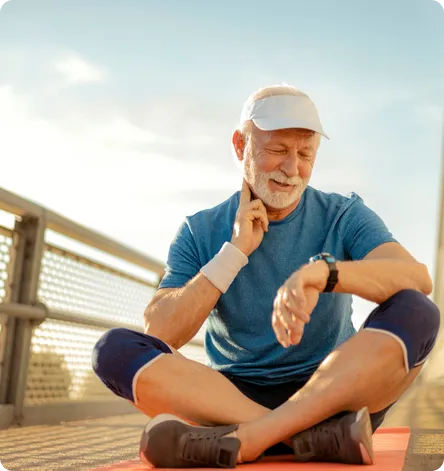
For Long-Term Health Span and Resilience
HRV naturally declines with aging, reflecting progressive reduction in autonomic nervous system flexibility.
However, individuals who maintain higher HRV as they age demonstrate better health span—more years of healthy, functional life with reduced disease burden.
Higher HRV in older adults predicts lower mortality risk, reduced cardiovascular events, better cognitive function, and maintained physical capacity. Essentially, HRV reflects your “biological age” more accurately than chronological age.
Maintaining and improving HRV through vagus nerve stimulation represents an anti-aging intervention targeting the autonomic nervous system—one of the fundamental systems governing longevity.
- HRV decline with aging reflects autonomic nervous system deterioration one of the hallmarks of biological aging
- Higher HRV in older adults predicts extended health span with more years of healthy function
- Maintaining HRV slows biological aging by preserving autonomic nervous system capacity
- Vagal stimulation actively improves HRV even in older individuals, potentially slowing autonomic aging
- HRV represents a modifiable longevity biomarker unlike genetic factors, HRV can be improved through targeted intervention
“I was told by a professional that they weren’t sure what was causing my challenges, but a long-term approach was suggested. I started researching ways to support myself and discovered Nurosym.”
– TREVOR, UK
The Mechanism: How VNS Optimizes Your HRV
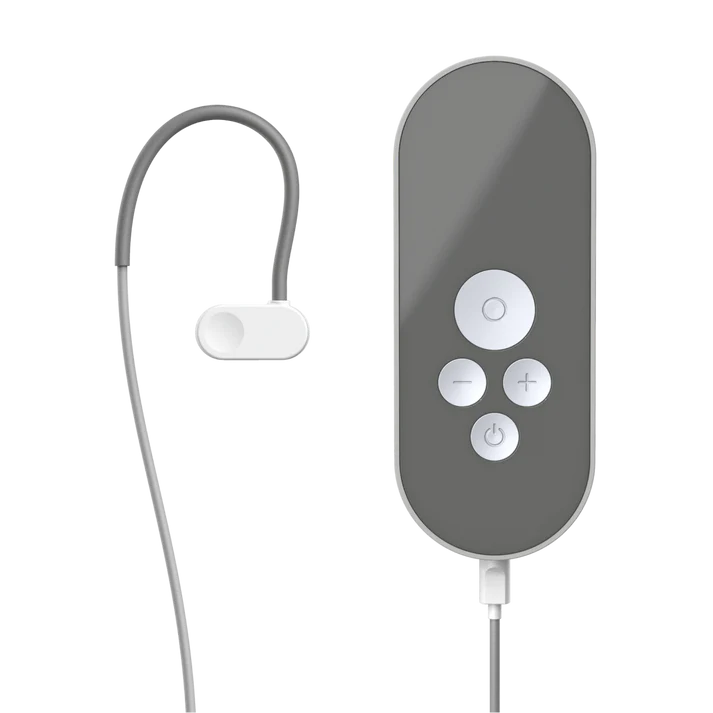
Auricular Vagal Neuromodulation Therapy (AVNT™) — Nurosym’s proprietary protocol developed with University of Chicago, UCLA, Imperial College London, and 60+ research institutions, specifically validated for HRV optimization across 4+ million supervised sessions.
How It Works:
Your HRV is created by your vagus nerve’s influence on your heart. When your vagus nerve is active, it releases signals that slow your heart rate and create variation between beats. Stronger vagal activity = higher HRV.
Nurosym delivers precisely calibrated electrical signals to your vagus nerve through your ear, activating the direct pathway that increases HRV:
- Peripheral Activation: Electrical stimulation activates vagal nerve fibers in your ear’s cymbal conchae—the optimal location for HRV enhancement
- Brainstem Transmission: Signals travel to the nucleus tractus solitarius (NTS)—your primary autonomic control center
- Cardiac Vagal Pathway Activation: The NTS connects to the dorsal motor nucleus and nucleus ambiguus—the brainstem centers that send vagal signals directly to your heart
- Heart Pacemaker Modulation: Vagal signals reach your sinoatrial node (heart’s pacemaker), increasing parasympathetic influence and creating greater beat-to-beat variability
- Autonomic Balance Restoration: Simultaneously reduces sympathetic overactivation while enhancing parasympathetic tone
- HRV Optimization: The result is measurably increased HRV across all validated metrics (time-domain, frequency-domain, and nonlinear measures)
Measurable Outcome: Immediate HRV increases observable within minutes, plus cumulative baseline improvements developing over weeks of consistent use.
Acute HRV Effects:
- Significantly enhances parasympathetic nervous system activity with measurable changes in HRV markers appearing within one hour (statistically significant at p=0.002), with effects lasting 2-4 hours after each session
- Immediate measurable changes in heart rate variability patterns observable through standard HRV analysis during and after sessions
- Sustained vagal activation with HRV elevation continuing for hours after stimulation ends
Cumulative HRV Improvements:
- Significant increases in time-domain HRV metrics including SDNN (standard deviation of normal-to-normal intervals)—the measure of overall autonomic health—across multi-week intervention periods
- Significant increases in RMSSD (root mean square of successive differences)—the validated measure of parasympathetic activity
- Improved LF/HF ratio indicating better autonomic balance, with statistically significant favorable shifts demonstrated in placebo-controlled trials (p=0.002)
- Enhanced stress reactivity and recovery with accelerated HRV recovery following stressors
Multi-System Benefits Validated in Clinical Studies:
- 35% reduction in anxiety symptoms as measured by validated BURNS Anxiety Inventory within 10 days, with sustained improvements at one-month follow-up (p < 0.001[2]
- 31% improvement in sleep quality scores using the Pittsburgh Sleep Quality Index over 4 weeks (p < 0.05)[3]
- 48% reduction in fatigue severity as measured by Pichot Fatigue Scale within 10 days (p < 0.0001), with sustained improvements maintained after treatment completion[4]
- Significantly reduces inflammatory markers including IL-6 in randomized placebo-controlled trials over 3 months, correlating with improvements in fatigue, cognitive function, and stress resilience
- Significantly improves attention and inhibitory control as measured by validated cognitive testing, with measurable gains within 10 days (p < 0.01) and sustained improvements at one-month follow-up (p < 0.001)
Real-World Effectiveness:
- Over 4 million user sessions completed worldwide
- Users reporting clinically meaningful improvements in stress resilience, recovery capacity, or overall health
- High adherence rates facilitated by objective biometric feedback showing measurable progress
- Benefits can be tracked with all major consumer wearables including Oura Ring, WHOOP, Apple Watch, Garmin devices, and Polar H10, enabling users to track their personal HRV improvements in real-time
These HRV improvements translate to meaningful health benefits: enhanced stress resilience, improved cardiovascular health, better sleep quality, faster recovery, and reduced disease risk.
For individuals seeking evidence-based HRV optimization—whether for performance enhancement, health span extension, stress resilience, or cardiovascular protection—Nurosym represents the most thoroughly validated, measurable intervention available.
Track your progress objectively. Optimize the biomarker that matters most. Build a more resilient nervous system.
Nurosym is a CE-marked Class IIa medical device. Clinical outcomes represent average results from controlled studies and real-world effectiveness analyses. Individual responses vary. The device is intended for general wellness and autonomic function optimization; it is not intended to diagnose, treat, cure, or prevent any disease. Users with pacemakers, arrhythmias, epilepsy, or other significant medical conditions should consult healthcare providers before use. HRV measurements and interpretations should not replace professional medical advice.
Resources:
Auricular Vagal Neuromodulation Therapy (AVNT) — Improves Sleep Score in Long-COVID: A Pilot Study, Nurosym Ltd. The pilot study reports significant improvements in sleep disturbance scores in individuals with Long-COVID following AVNT intervention. Available at: https://nurosym.org/fr/pages/auricular-vagal-neuromodulation-therapy-improves-sleep-score-in-long-covid-a-pilot-study
Auricular Vagal Neuromodulation Therapy (AVNT) — Anxiety Symptoms Reduction in Long COVID Patients After Auricular Vagal Neuromodulation Therapy, Nurosym Ltd. The home-based 10-day intervention (twice daily sessions) among Long COVID patients showed a significant and sustained reduction in anxiety scores (pre-intervention, post-intervention, 1-month follow-up). Available at: https://nurosym.org/fr/pages/anxiety-symptoms-reduction-in-long-covid-patients-after-auricular-vagal-neuromodulation-therapy
Auricular Vagal Neuromodulation Therapy (AVNT) — Improves Sleep Score in Long COVID: A Pilot Study, Nurosym Ltd. The pilot trial reported significant improvements in sleep disturbance scores among Long COVID patients following AVNT intervention. Available at: https://nurosym.org/fr/pages/auricular-vagal-neuromodulation-therapy-improves-sleep-score-in-long-covid-a-pilot-study
Auricular Vagal Neuromodulation Therapy (AVNT) — “Reduces Fatigue in One-Group Assignment in Post-Viral Syndrome Patients”, Nurosym Ltd. The 10-day (daily 35-minute) intervention reported an approximate 48% improvement in Pichot Fatigue Scale scores (D0 vs D10, p < 0.0001). Available at: https://nurosym.org/fr/pages/auricular-vagal-neuromodulation-therapy-avnt-reduces-fatigue-in-one-group-assignment-in-post-viral-syndrome-patients
Share via:

